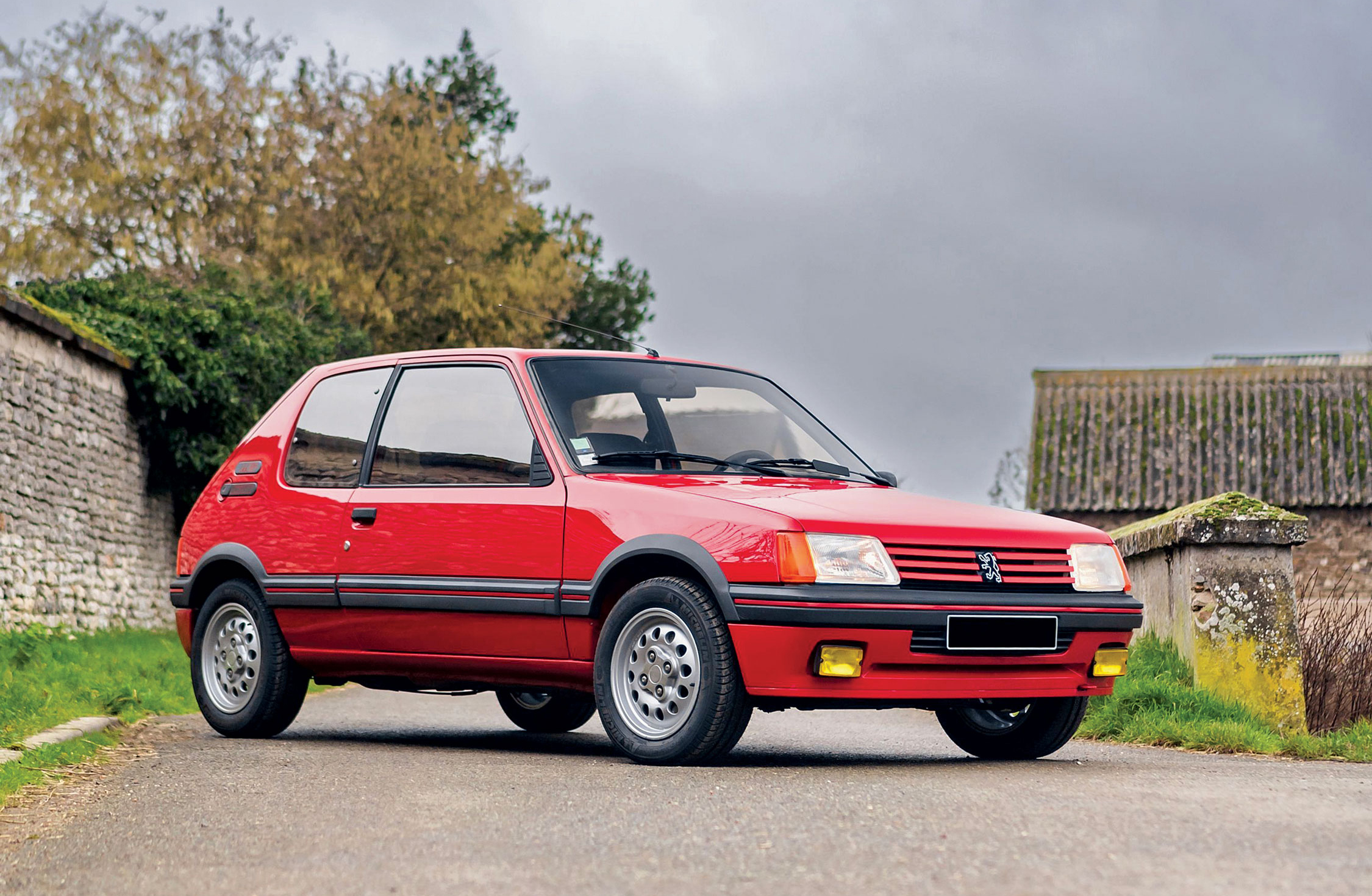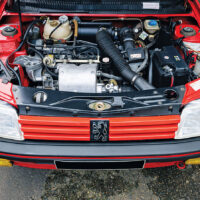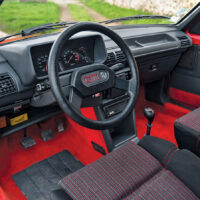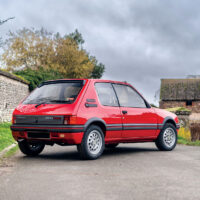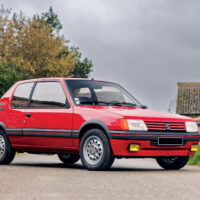At the Geneva Motor Show in March 1984, Peugeot presented the 205 GTI, a sporty version of the 205 city car it had launched a year earlier. Initially offered in a 1.6-L, 105-hp version, in March 1986 it became available with 115 hp as an option, and by the end of that year the option became standard, as did a 1.9-L version developing 130 hp.
The GTI on sale is part of the first series with Jaeger instruments, and remains the most sought-after today. It was sold new on December 7, 1984, by the Peugeot Ortelli garage in Hyères, and has known only two owners. The first, a certain André Clavel, kept it from 1984 to 2010 before selling it to the current owner. But the incredible thing is its very low original mileage: 33,400 km! Just imagine what exceptional condition this 205 is in. It has just been completely serviced, with four new tires, new silent blocks, rear brakes, timing system and water pump and, of course, all fluids changed. The interior is immaculate, fresh from the dealership, with superb carpets and first-class paintwork.
Many 205 GTIs have suffered harsh treatment by their successive owners, and some have even been tuned, so it’s truly rare to find an original 205 GTI delivered with all its booklets and manuals, and in such condition — moreover, in the same color as when it was launched.
SCM Analysis
Detailing
| Vehicle: | 1984 Peugeot 205 GTI 1.6 |
| Years Produced: | 1984–94 |
| Number Produced: | 294,514 |
| Tune Up Cost: | $300 |
| Chassis Number Location: | Stamped on plate riveted behind right front strut tower and etched into drip rail above it |
| Engine Number Location: | Plate riveted to engine block and/or stamped lower down |
| Club Info: | Peugeot Sport Club U.K. |
| Website: | http://pscuk.net |
| Alternatives: | 1976–91 Volkswagen Golf GTI 1981–88 Ford Fiesta XR2 1987–93 Opel Corsa GSi |
This car, Lot 117, sold for $33,729 (€30,992) at Artcurial’s Paris, FRA, auction on February 2, 2024.
The Peugeot 205 GTI was hailed at launch as “the Mini Cooper of the ’80s,” when the press raved over its peppy engine, direct steering and biddable, throttle-adjustable chassis. Even today it’s considered the hot-hatch benchmark by many and Peugeot has never recaptured its magic. (Some of that same press later retrospectively branded the cars “dangerous” for the very lift-off oversteer that makes them entertaining, but that’s a sign of our health-and-safety-obsessed times.)
If you’re scratching your head here — yes, the seminal Volkswagen GTI came first — Peugeot’s GTI was and is more a European infatuation. Indeed, the 205 range was What Car?’s Car of the Year for 1984 and was declared “car of the decade” by Car in 1990.
The over-under
These hatchbacks came from an age when Peugeot was at the top of its game in respect to chassis engineering, the marque having been renowned for decades for its fine ride and handling. The 205 GTI confirmed that front-wheel drive did not necessarily have to equate to relentless understeer. Combining neat hatchback styling with a comparatively large 1,580-cc engine and fuel injection, then still quite a novelty on cars of this size and class, made an appealingly fizzy package. Though 105 hp and 98 lb-ft looks puny today, there was less than 2,000 pounds to move. At the end of 1986 the 1.6 was upgraded to 115 hp to combat rivals from Ford and VW, and to distance it from the new, longer-stroke 1,905-cc version with near 130 hp.
The 205’s secret was in its suspension. Though the design is a basic MacPherson-strut front with rear trailing arms, the rear subframe’s rubber mountings allow a subtle element of passive rear steer. This was perfected on the following 306, a car that really doesn’t know if it’s front or rear drive. These ’80s and ’90s small Peugeots handle pretty much like a Mini, in that you can chuck them into corners and adjust the chassis’ attitude on the throttle, lifting slightly to let the rear drift a little before getting back on the gas to stabilize it, a variation on the “lift, aim, squirt” technique familiar to 911 airheads. This generation of rear suspensions, first seen on the 305, is compact, too, which is important on a small car. Springing is by transverse torsion bars, and the dampers lay flat beside the trailing arms, the whole lot mounted up under the unintruded trunk at four points.
Inevitably, the 205, like the Mini before it, became the darling of tuners, boy racers and rallyists thanks to a combination of lightness, cheapness and ease of modification. (My favorite is a 160-hp twin-cam-motor transplant from the 405 Mi16.) This means that finding an unmolested one has never been easy. But their rise in values and growing status as a collectible means that a small but steady supply trickles through auctions if you know where to look — mostly Artcurial, and in the U.K. Iconic (previously known as Silverstone).
Which is which?
There are three main variations, and lots of limited editions, but 205 GTI production breaks down broadly as:
- 1.6-L, 105 hp. These were produced from April 1984 to April 1986, with 14-inch wheels, front disc brakes and rear drums. The CTI (from June 1986) is the convertible model; the last ones are 1.9s.
- 1.6-L, 115 hp. Produced from April 1986 to September 1992.
- 1.9-L. Produced from December 1986 to April 1994, with 15-inch wheels (with larger and fewer holes, though the tire section width remains 185 mm), half-leather interior, and disc brakes all around. Initially made 128 hp, then 122 hp with catalytic converter from late 1992.
- “Phase 1.5” models were built from late 1987 (October) with less painted metal inside and fewer rattles, an updated dash with rotary rather than slider heater controls, plus a three-spoke steering wheel. Power steering was an option from September 1989.
- “Phase 2” models were built from 1991 with a black dash, clear front indicators and smoked taillights. English cars tend to have ugly sliding sunroofs, but these won’t be bothering left-hand-drive markets too much.
- A rare variation, but worth mentioning here, is the minimalist (1,750-pound) Euro-spec 205 Rallye. This is basically a 1.6 GTI but with a slightly higher power-to-weight ratio, using an all-aluminium, 102-hp, 1,294-cc TU on twin carbs. Only 1,000 were made.
- The 200-off 205 T16 is a completely different animal, a turbo mid-engined, 4WD rally homologation special.
Our subject car is an early 1.6 GTI, with Jaeger rather than Veglia instruments, and the least-powerful engine. It has all-cloth seats, but having covered only around 21,000 miles, all the fabric is good. Pleasingly, it is absent the optional sunroof that afflicted many. It will also have escaped getting the power steering which (optionally) lumbered some late 1.9s and took the fine edge off the car. With full service history and cam belt and water pump just done again, it was sold without technical inspection, but that won’t affect the value, as it is in near-mint condition.
While the shorter-stroke and sweeter-revving 1.6 has its devotees, the money has so far generally been in the 1.9s, as people remember them as the edgier drive when new. Artcurial sold a low-miles 1.9 for $53,798 at this auction two years ago (SCM# 6951993) and the world record appears to be the $59,790 it took on a 1.9 Griffe special edition in Paris in 2018 (SCM# 6869903). In England in February, Iconic sold a low-mileage Miami Blue 1.9 for $53,954. But as the 205 GTI establishes itself as a proper collectible, we would expect the discerning to look to the rarer earlier editions, like our first-year example. Offered at no reserve, this very original car sold market-correct today, and was astutely bought. ♦
(Introductory description courtesy of Artcurial.)
